Nightlife venues play a crucial role in ensuring the safety and comfort of their patrons by incorporating essential safety features and security measures. From emergency lighting and trained security personnel to metal detectors and accessible facilities, these venues strive to create a secure and inclusive environment for all guests. By prioritizing accessibility, they ensure that everyone, regardless of ability, can enjoy the vibrant nightlife experience.
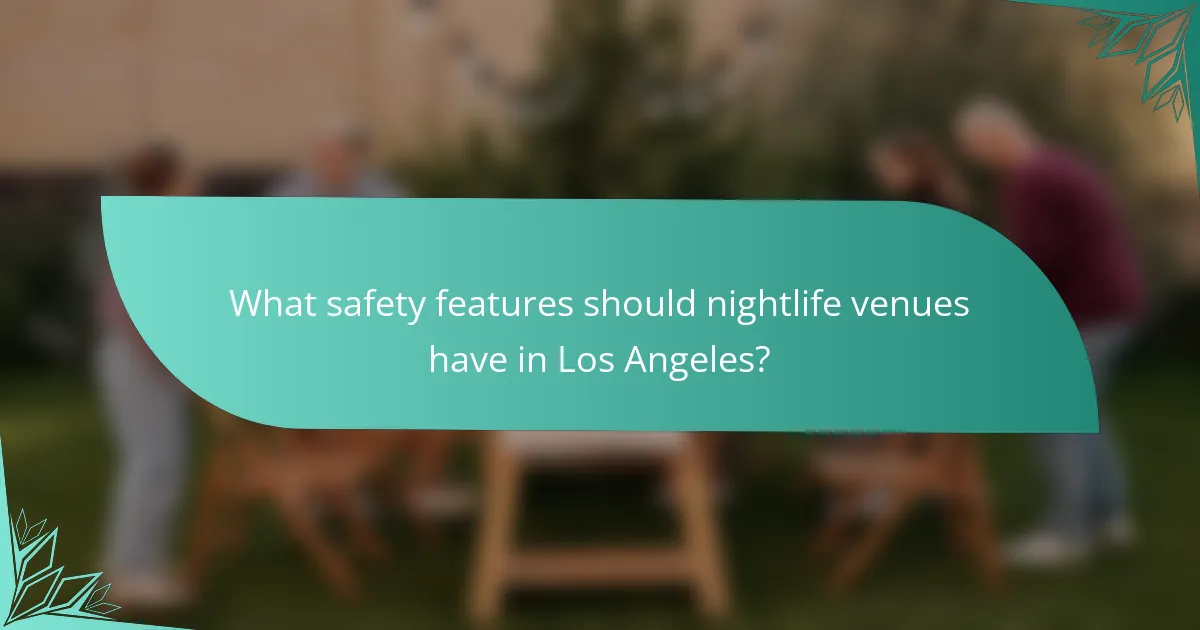
What safety features should nightlife venues have in Los Angeles?
Nightlife venues in Los Angeles should prioritize safety features that protect patrons and staff. Essential elements include emergency lighting, surveillance systems, trained security personnel, accessible emergency exits, and readily available first aid kits.
Emergency lighting systems
Emergency lighting systems are crucial for ensuring visibility during power outages or emergencies. These systems should automatically activate and illuminate exits, pathways, and critical areas, allowing for safe evacuation.
Venues should regularly test these systems to ensure functionality, ideally conducting checks monthly. Compliance with local fire codes is essential, as they often dictate the requirements for emergency lighting.
Surveillance cameras
Surveillance cameras enhance security by monitoring activities within and around the venue. They deter criminal behavior and provide valuable evidence in case of incidents.
It is advisable to install cameras in high-traffic areas, entry points, and near cash handling locations. Regular maintenance and monitoring of these systems are necessary to ensure they are operational and effective.
Trained security personnel
Having trained security personnel is vital for maintaining a safe environment. These individuals should be skilled in conflict resolution, emergency response, and crowd management.
Venues should ensure that security staff undergo regular training sessions and are familiar with the layout of the venue, emergency procedures, and local laws. This preparedness can significantly reduce risks and enhance overall safety.
Emergency exits
Emergency exits must be clearly marked and easily accessible to facilitate quick evacuation during emergencies. Each exit should be free of obstructions and equipped with illuminated exit signs.
Regular drills can help familiarize staff and patrons with exit routes, ensuring everyone knows how to respond in an emergency. Compliance with local building codes regarding the number and placement of exits is also essential.
First aid kits
First aid kits should be readily available in nightlife venues to address minor injuries or medical emergencies. These kits should be stocked with essential supplies, including bandages, antiseptics, and other basic medical items.
Venues should designate specific locations for these kits and ensure staff members are trained in their use. Regularly checking and restocking supplies is crucial to maintain readiness for any situation that may arise.
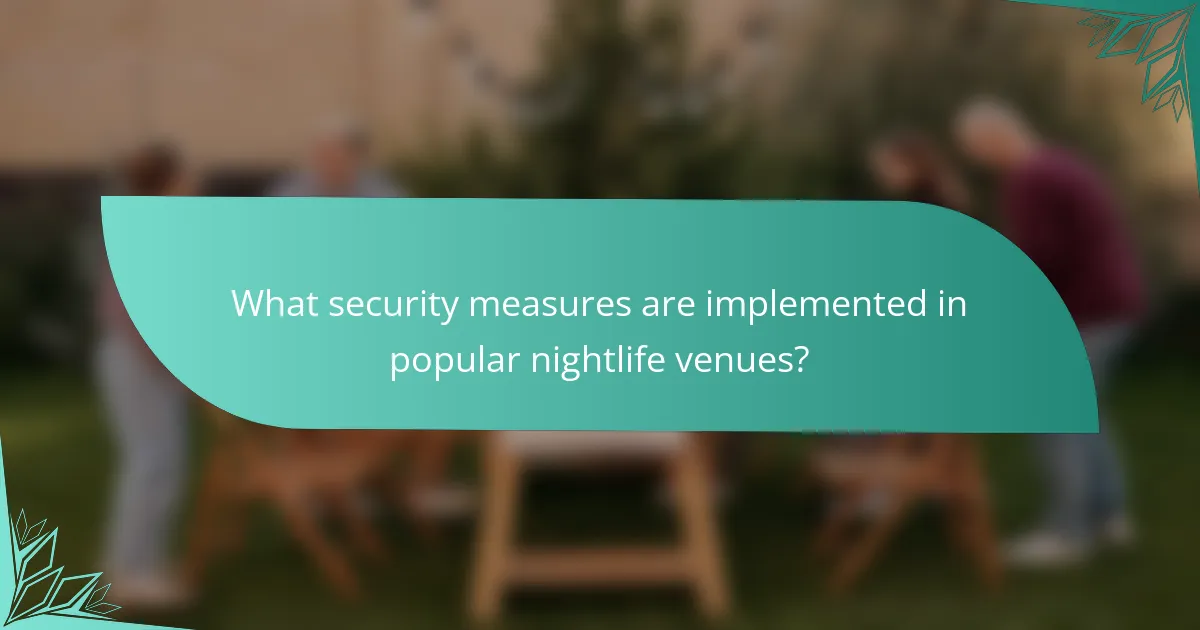
What security measures are implemented in popular nightlife venues?
Popular nightlife venues often implement a variety of security measures to ensure the safety of patrons and staff. These measures typically include metal detectors, bag checks, and identification verification to prevent incidents and maintain a secure environment.
Metal detectors at entrances
Metal detectors are commonly used at the entrances of nightlife venues to screen guests for weapons or prohibited items. These devices can quickly identify metallic objects, allowing security personnel to address potential threats before entry.
When entering a venue with metal detectors, patrons should be prepared for a brief wait, especially during peak hours. It’s advisable to minimize the number of metallic items carried, such as keys or coins, to expedite the screening process.
Bag checks
Bag checks are another prevalent security measure in nightlife venues, where staff inspect bags for prohibited items like weapons, drugs, or outside beverages. This process helps ensure a safer atmosphere for everyone attending the event.
Guests should expect to have their bags opened and examined upon arrival. To facilitate a smooth entry, it’s best to carry only essential items and avoid bringing large bags or backpacks, which may require more thorough inspection.
Identification verification
Identification verification is crucial in nightlife venues to ensure that patrons meet age requirements for alcohol consumption and entry. Staff typically check IDs against a list of accepted forms, such as government-issued photo identification.
Patrons should have their IDs readily accessible to speed up the entry process. It’s important to note that some venues may use scanners to verify the authenticity of IDs, so guests should ensure their identification is not damaged or altered to avoid complications at the door.
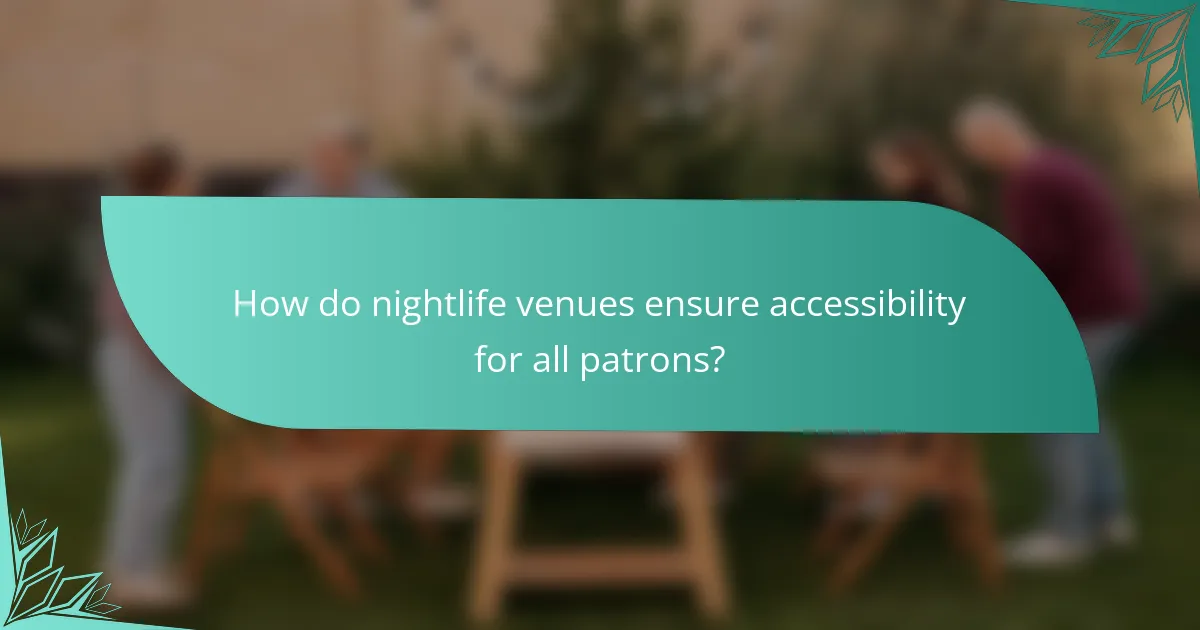
How do nightlife venues ensure accessibility for all patrons?
Nightlife venues implement various accessibility features to accommodate all patrons, ensuring that everyone can enjoy their experience. Key measures include wheelchair ramps, accessible restrooms, and designated seating areas, all designed to enhance mobility and comfort for individuals with disabilities.
Wheelchair ramps
Wheelchair ramps are essential for providing access to nightlife venues, allowing individuals with mobility challenges to enter and navigate the space. These ramps should comply with local regulations, typically featuring a gentle slope and non-slip surfaces to ensure safety. Venues should regularly inspect ramps for maintenance and clear any obstructions that may impede access.
When planning an outing, check if the venue has multiple entry points with ramps, as some locations may have limited access. Additionally, consider contacting the venue in advance to confirm the availability and condition of these ramps.
Accessible restrooms
Accessible restrooms are a crucial component of nightlife venue accessibility, designed to accommodate patrons with disabilities. These restrooms often feature wider stalls, grab bars, and lower sinks to facilitate ease of use. Venues should ensure that these facilities are well-maintained and clearly marked for visibility.
It’s advisable to verify the number of accessible restrooms available, especially in larger venues. Some establishments may offer a family restroom that can be used by individuals requiring assistance, which can be a convenient option for caregivers and families.
Designated seating areas
Designated seating areas for patrons with disabilities provide a comfortable and safe space within nightlife venues. These areas should be strategically located to offer good visibility and easy access to amenities, such as restrooms and exits. Venues must ensure that these seats are reserved and available for those who need them.
When attending an event, inquire about the availability of designated seating and any reservation policies. Early communication with the venue can help secure appropriate accommodations, ensuring a more enjoyable experience for everyone involved.

What are the legal requirements for safety and security in nightlife venues?
Nightlife venues must comply with various legal requirements for safety and security, which typically include local fire codes and health and safety regulations. These laws are designed to protect patrons and staff, ensuring a safe environment for entertainment and socializing.
Local fire codes
Local fire codes dictate the safety standards that nightlife venues must meet to prevent fire hazards and ensure safe evacuation. These codes often specify the number of exits required, the installation of fire alarms and sprinklers, and the maintenance of clear pathways for emergency egress.
For example, venues may be required to have at least two exits for every 100 occupants, with specific signage indicating the nearest exit. Regular inspections by fire marshals ensure compliance, and failure to meet these codes can result in fines or closure.
Health and safety regulations
Health and safety regulations encompass a range of standards aimed at maintaining a safe environment for patrons and employees. These regulations cover aspects such as food safety, sanitation, and the management of crowd control to prevent accidents.
Venues must ensure that food and beverages are prepared and served in compliance with health codes, which may include regular inspections by local health departments. Additionally, proper training for staff on emergency procedures and first aid can significantly enhance safety in nightlife settings.
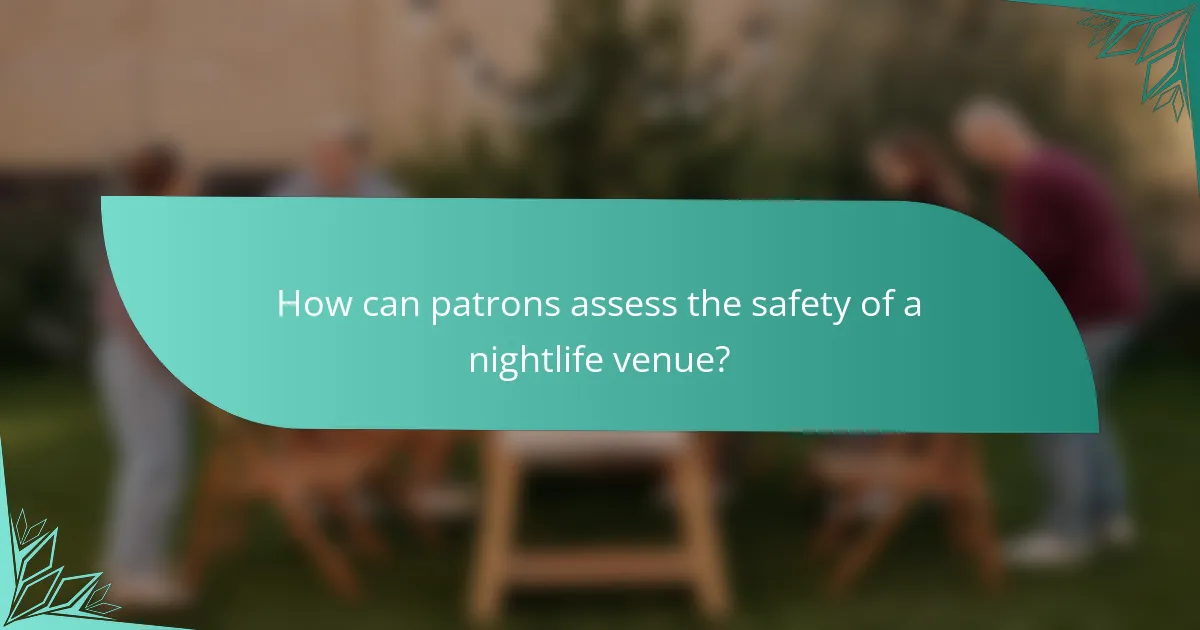
How can patrons assess the safety of a nightlife venue?
Patrons can assess the safety of a nightlife venue by evaluating its security measures, online reputation, and accessibility features. Key indicators include the presence of security personnel, reviews from previous visitors, and the venue’s compliance with safety regulations.
Checking online reviews
Online reviews are a valuable resource for gauging the safety of a nightlife venue. Look for comments regarding security incidents, crowd behavior, and overall experiences shared by patrons. Websites like Yelp or Google Reviews often provide insights into how well a venue manages safety concerns.
Pay attention to patterns in the reviews. If multiple users mention issues like theft or inadequate security, it may be a red flag. Conversely, positive feedback about a venue’s safety measures can indicate a more secure environment.
Observing security presence
A visible security presence is a strong indicator of a nightlife venue’s commitment to safety. Check for security personnel at entrances, throughout the venue, and in high-traffic areas. Their training and demeanor can also reflect the venue’s overall safety culture.
Consider the ratio of security staff to patrons. A good rule of thumb is one security personnel for every 50 to 100 guests, depending on the venue size and type of event. Additionally, assess how security interacts with guests; proactive and approachable staff can enhance the feeling of safety.
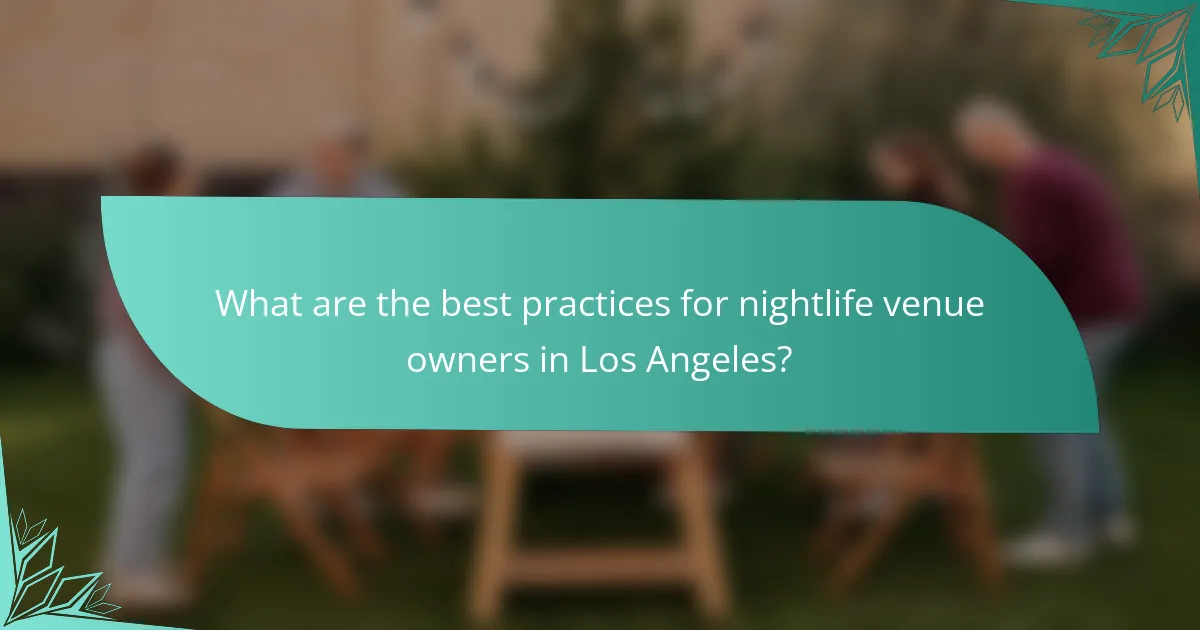
What are the best practices for nightlife venue owners in Los Angeles?
Nightlife venue owners in Los Angeles should prioritize safety, security, and accessibility to create a welcoming environment. Implementing effective safety measures and training staff can significantly enhance the overall experience for patrons while minimizing risks.
Regular safety drills
Conducting regular safety drills is essential for preparing staff and patrons for emergencies. These drills should cover various scenarios, such as fire evacuations, active shooter situations, and medical emergencies. Aim to hold drills at least quarterly to ensure everyone is familiar with procedures.
During these drills, staff should practice their roles and responsibilities, helping to identify any gaps in the venue’s emergency response plan. Consider involving local emergency services to provide guidance and feedback, which can enhance the effectiveness of these drills.
Staff training programs
Comprehensive staff training programs are crucial for maintaining a safe nightlife environment. Training should cover conflict resolution, crowd management, and first aid, equipping employees with the skills needed to handle various situations. Regular refresher courses can help keep knowledge current and reinforce best practices.
Additionally, consider implementing a buddy system where experienced staff mentor newer employees. This approach fosters a culture of safety and ensures that all team members are prepared to respond effectively to any incidents that may arise in the venue.

How do nightlife venues respond to safety incidents?
Nightlife venues typically respond to safety incidents by implementing a combination of immediate actions and long-term strategies aimed at enhancing security and ensuring patron safety. These responses often include trained staff, surveillance systems, and emergency protocols to manage various situations effectively.
Emergency protocols and staff training
Emergency protocols are essential for nightlife venues to handle incidents like fights, medical emergencies, or fire hazards. Staff training often includes first aid, conflict resolution, and evacuation procedures. Regular drills can help ensure that employees are prepared to act quickly and efficiently during an emergency.
Surveillance and security personnel
Many nightlife venues invest in surveillance systems, including CCTV cameras, to monitor activities and deter potential incidents. Additionally, hiring trained security personnel can provide a visible presence that enhances safety and helps manage crowds. Security staff should be well-versed in local laws and regulations to handle situations appropriately.
Communication with local authorities
Establishing strong communication channels with local law enforcement and emergency services is crucial for nightlife venues. This collaboration can facilitate quicker responses to incidents and help venues stay informed about any safety concerns in the area. Regular meetings with local authorities can also enhance community relations and improve overall safety strategies.
Accessibility considerations
Accessibility is a vital aspect of safety in nightlife venues, ensuring that all patrons can enjoy the space without barriers. Venues should comply with local regulations regarding accessibility, such as providing ramps, designated seating, and accessible restrooms. Regular assessments can help identify areas for improvement and ensure compliance with standards.


